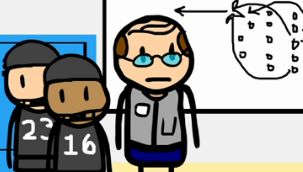The Path-Goal Theory and Leadership Styles
After you watch the video and know the material, click HERE for the quiz.
Path-Goal is a type of leadership theory that focuses on establishing a clear path to goal achievement. Leadership styles that are associated with this theory include: achievement-oriented, directive, participative and supportive leadership.
The Path to Goal Achievement
Robert J. House, founder of Path-Goal theory, believes that a leader's behavior is contingent to employee satisfaction, employee motivation and employee performance. Path-Goal theory states that a good leader provides clear direction, sets high goals, gets involved in goal achievement and supports his employees. The employees, as a result, will be a more satisfied and productive team. It also states that employees will accept a leader's direction if the employee believes that there will be an immediate or future benefit that results from work.
 |
Path-Goal Leadership Styles
There are several different directions a running back can take to get from the 50-yard line to the end zone. Depending on the circumstance, he may run directly to the end zone, serpentine from one sideline to the other or charge into a group of opposing players. Path-Goal leadership styles work in similar ways. Just as there are different paths to the end zones, there are different paths to leading a team. There are various leadership styles associated with Path-Goal theory:
- Achievement-oriented leadership
- Directive leadership
- Participative leadership
- Supportive leadership
 |
Achievement-Oriented Leadership
In achievement-oriented leadership challenging goals are set, high performance is expected and management has a high level of confidence in the employee's ability to achieve the goals. This style of leadership is well suited for quarterbacks to use on other team members. The coordinator or coach gives the quarterback a set of goals and plays. The main goal is to win games, but there are smaller, equally important goals for the execution of plays during a game. The coordinator provides the quarterback with the playbook and sets the expectation for performance - all with a high level of confidence that the quarterback can direct the team to execute the right plays at the right time and win games.
 |
Directive Leadership
The quarterback uses a different leadership style with different players. A quarterback gives directives by assigning specific plays to the team and to individuals. Directive leadership involves giving specific advice or directives, clarifying expectations and assigning tasks to individuals or a group.
During a huddle, the quarterback gives players the directives (or plays) and manages from the field. An individual player, like a wide receiver, may be directed to be in a certain area of the field to receive the ball. He may also be directed where to run with the ball. A group of linebackers may be directed to tackle certain players on the opposing team. Regardless of the position, each player must carry out the play according to the quarterback's expectations.
 |
Participative Leadership
The quarterback does not always have the final say. The team is given the opportunity to participate in play strategies. This is a participative leadership style. Participative leadership involves sharing information between the manager and the group to gather input for goal achievement.
When the team gathers in the locker room prior to the game, the head coach, coordinators, quarterback and players discuss the overall game strategy and individual plays for the day. Team members provide feedback. The plays are discussed between members of the group to determine the best possible strategies for winning the game.
Supportive Leadership
Some players require a more sensitive leadership style simply because of their position. While all players play hard on the field, some are more prone to injury. Running backs are especially prone to injuries. Players in this position must be able to run fast, move out of the way of burly linebackers and make nimble jumps over piles of downed players.
Supportive leadership is necessary for these players. Managers foster good relations and show personal concern for the health and well-being of the individual or group. Coordinators know that running backs have a physically challenging position. Running backs are often taken out of the game for rest periods. There is also more than one running back on the field. This reduces the physical stress on any one running back. Running backs are also given special massages and even therapies for their leg and shoulder muscles.
 |
Lesson Summary
Path-Goal theory establishes a clear path to goal achievement. There are various leadership styles that managers can use to do this:
- In achievement-oriented leadership managers set challenging goals, have high performance expectations and have a high level of confidence in the employee's ability to achieve the goals.
- Directive leadership involves giving specific advice or directives, clarifying expectations and assigning tasks to individuals or a group.
- Managers who use participative leadership share information with the group to gather input for goal achievement.
- Supportive leadership fosters good relations between managers and employees. Managers exhibit personal concern for the health and well-being of the individual or the group.